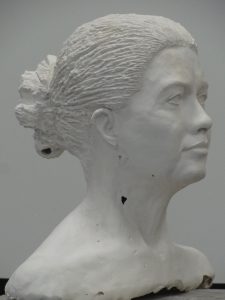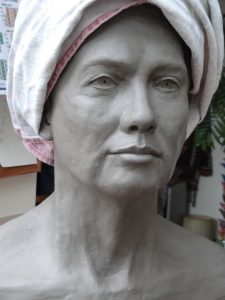As Garrison Kiellor was oft to say “It been a quiet time…”. Last post was the end of Jan and I suggested that I would post about remodelling the eyes of the last bust. However, I am not happy with outcome and not able to improve on matters for technical reasons [not enough plaster to gouge into]. So, the bust is now sitting in the dining room and I turned to the next project.
When Ed, my tutor, saw the second bust he asked if I would be interested in doing a full-size sculpture of a person – what an opportunity – of course! Much of my time since then has been spent on that project [which I shall write about later] but more recently I have been exploring making moulds. I do not want to make a waste mould on a full-size sculpture, so I have been looking at flexible moulds with outer, harder casings: The harder casing stops the flexible mould distorting while casting and then you pull the casing off the flexible mould and peel the flexible mould off the cast- simple with lots of detail and not many mould pieces. However, there are several ways of making the flexible moulds and most are messy and expensive.
The budget moulding material is silicone frame sealant in equal weight to cornflour and then about 20% to that combined weight of mineral oil – I chose to use some coloured paraffin [bought ages ago for a lamp]. The resulting glup was spread onto a walnut and put on a piece of paper to set.
The nut sunk down while the glup set to give a hole in the base so when I partly filled it with plaster the stuff dribbled out but here’s the nut and the cast. You can see the “flashing”, the fine excess sheet of plaster [which got pared off].
I did another walnut mould and kept the gulp and nut moving in my gloved hands until it was a lot more set – got a good cast with hardly any flashing to prise off. Thought I’d try colouring the plaster mix – used ink – and off again. By the way, the pins are used to attempt to hold the cut line together while the mould is moved around to distribute the plaster and stop the plaster running out of the mould.
However, both times with ink and the plaster set very fast – probably the ink changed the pH. Then onto the espresso coffee pot; lots of flat surfaces and direction changes.
Set the pot level on it’s side and build a clay wall with a stopper in the spout. Decided to do the base and half a side and half top as one mould piece. Mixing the ingredients was very much like making fondant icing.
Then tried to build a casing but as it was the weekend settled on “filler” as I had no plaster. But that was a disaster! it wouldn’t set! Turned over and cleaned other side for the next coat.
Tried making a casing in plaster at college but ran into problems because of the rubbish “filler” casing it was to abut against. Here you can see how the “filler” casing crumbled with little or no provocation.
I decided to try making a cast without any casing. Without the casing, and as many pins as I thought should have been enough, the mould pieces didn’t hold together and leaked the plaster while it was runny. Lots of moving the mould around to distribute the plaster while it was leaking from several places.
Pins out and open the mould carefully I found the handle had come off and then the bottom fell in! The pot is a bit out of kilter, which I find interesting, and the surface has extra bits of plaster, which look a bit like crystals [but are actually distorted “bubbles” where the mould material was not spread against the pot].
Sitting on a bit of wood [so air can get in] over a candle and it presents as an interesting light feature.
The last few days of moulding and casting has given me a lot of experience to draw upon. However, it was all thrown into stark contrast by visiting the studio of Sally Arnup, a great animal sculptor who lived on the edge of York. I just looked at her moulds and thought, “Oh, that’s why my casings were useless and why my flexible moulds should have locating lugs for the casings”. Next time my moulds will be much better.





























































































































